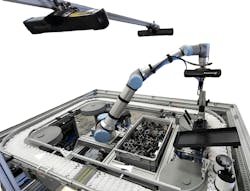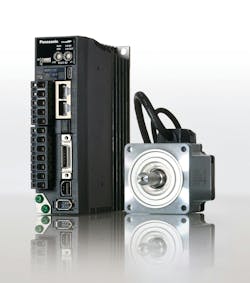Physical AI in Motion: How Machine Learning Drives Next-Gen Industrial Automation
Key Highlights:
- Physical AI enables machines to perceive their environment through sensors and make real-time decisions, enhancing automation in industries like manufacturing and logistics.
- Market forecasts indicate the industrial AI sector will grow over threefold to nearly $154 billion by 2030, driven by increased adoption among large manufacturers.
- AI-driven servo tuning and predictive maintenance software are significantly reducing setup times and operational costs for CNC machines and robotics.
Enjoying Machine Design’s Industrial Equipment & Heavy Machinery content? Be sure to check out the rest of our Takeover Week coverage here.
While generative AI, including large language models (LLMs) such as gpt-4 or Sora 2, has grabbed popular attention and investor enthusiasm, a separate branch of the field, physical AI, is emerging as a transformative force in industrial automation.
By and large, generative AI lives in the digital world, digesting large quantities of text, images and video to generate new digital content based on user prompts. In contrast, physical AI enables a machine, via sensor data, to perceive and “understand” its environment; compare that present state to an end-goal; and then make real-time decisions that guide a physical system toward a destination or optimized end-state.
A common example is an autonomous vehicle that, in navigating to a destination, employs LiDAR/radar/cameras for lane positioning and object recognition working in concert with a set of policies that encapsulate the rules of the road and the ability to break them should an emergency require it.
Whether generative or physical, AI for industrial applications is still in the early adoption stage, says an August 2025 IoT Analytics report, but with the likelihood of progressing rapidly. According to the market analysis firm, U.S. manufacturers spent an average of 0.1% of revenues on AI technology in 2024. However, that cohort, especially larger manufacturers, have now baked ML/AI adoption into their strategic plans, the report argues. As a result, the industrial AI market will more than triple to $153.9 billion by 2030, the report projects.
READ MORE: AI Agents vs. AI Copilots: What They Are and When to Deploy Them
To capitalize on that potential, industrial equipment vendors have launched a spectrum of ML/AI-enabled software/hardware in recent years. On the generative AI side, automation companies have jumped on the “copilot” trend. Siemens, for example, may be the most prolific, introducing a dozen or so such bots across its manufacturing software, ranging from the CompTIA copilot to help generate PLC code to its NX CAD copilot for documentation querying. Rockwell Automation, ABB, Dassault Systèmes and others have launched similar functionality.
Even so, generative AI accounted for only 5% of industrial AI expenditures in 2024, according to the IOT Analytics study. The bulk of industrial spending, to date, has focused on physical AI technology, primarily coupling it with machine vision to automate quality control and inspection applications.
AI in Motion Control: From Manual Servo Tuning to AI-Driven Precision
However, ML/AI is increasingly moving into more central automation and motion control applications. Servo tuning, for example, has historically been one of the more painful tasks in motion control. Once upon a time, experienced engineers might have spent days tweaking PID gains and filters to minimize overshoot and oscillations, all for a single axis.
Auto-tuning algorithms, ranging in complexity from step tests to iterative heuristic tuning techniques, have existed for more than a decade; however, in practice, these routines often require an experienced operator to set initial conditions and refine the auto-tuner's output.
Taking the concept to the next level, servo vendors have added AI-enabled functions to their configuration software. In early 2024, for example, Panasonic Industry introduced its MINAS A7 servo line, which adds an AI component to its PANATERM setup software, called precAIse tuning. In testing, Panasonic says precAIse tuning improved positioning settling time by 45%, compared to expert manual tuning, and achieved it in one-tenth of the time.
Real-World Applications: AI in CNC Machines and Robotics
Similarly, CNC and robotics firm Fanuc touts its own AI Servo Tuning software to save CNC technicians hours to days when initially setting up a machine tool or when used to help correct a CNC performance problem.
According to Rick Schultz, Fanuc’s executive director of Aerospace and Defense, AI servo tuning is a game change, especially when compared to the part-science, part-intuition “black art” days of CNC business more than 30 years ago.
“Let’s say we identify that there is a resonance that needs to be tuned; previously that could take anywhere from a day to a week, maybe even two weeks, to fix,” he says. “In our experience, with AI Servo tuning, we’re done in half a day.”
In addition, Schultz says the field has only so many expert servo turning technicians available to help service the millions of Fanuc CNC controls in the field globally and to set up those coming online each year. Each machine setup- and servo turning-related performance problem may accumulate costly downtime waiting for an expert to arrive on site. AI servo turning, he says, smooths over that variability in skill and availability.
“[Fanuc] has some phenomenal servo tuning people, but each has their own experience base and their own technique,” he adds. “If two people went to the same CNC machine and optimized it, they might take two totally different approaches. With AI-level servo tuning, you’re now getting a consistent, reliable and easier-to-support tuning process, done much faster. It doesn’t have the cumulative experience of a particular expert technician; the AI-tuning algorithm has the cumulative experience of a lot of expert technicians.”
Fanuc has taken a similar targeted AI approach to other common CNC productivity killers—namely machine maintenance and thermal expansion. Fanuc’s Servo Monitor software, for example, provides predictive maintenance for the company’s CNC equipment. Run on local computing hardware, the software builds an initial operational baseline over a handful of days. It then runs in the background, monitoring deviations from the baseline and drawing attention to potential problems before they become expensive malfunctions.
The company also offers AI Thermal Displacement Compensation, software designed for Fanuc’s latest control hardware that allows CNC operators to cut parts shortly after machine start up, rather than waiting for it to enter a thermally stable state capable of producing high precision parts, he says.
“[AI thermal Displacement Compensation] eliminates all that warmup time,” Schultz explains. “You can basically run from a cold machine, and the algorithm will have learned the thermal growth characteristics and will compensate as the machine warms up. Now, this requires specific sensor hardware to work right and it’s an intensive application but think about saving an hour warm-up cycle on your part manufacture. All manufacturing companies want their machines cutting parts, not just sitting there.”
AI’s Killer App?
While the examples above represent concrete applications of physical AI, in many quarters that term has become synonymous with AI-enabled robotic systems. In fact, physical AI may well be the “killer app” of ML/AI in general.
Sure, ChatGPT grabs the glory, with nearly 800 million weekly global users, but as of mid-2025, only 5% of those are paying customers, according to the Financial Times. Considering OpenAI recently pledged $1.4 trillion to build out its AI infrastructure over the next five years, it’s difficult to make the ROI on that investment pencil out unless its sales team drops into hyper-drive. And that doesn’t include the tens of millions CEO Sam Altman admitted on X that OpenAI has burned through in compute costs simply due to users collectively replying to ChatGPT with a “please” or “thank you.”
READ MORE: AI Gains Physical Intelligence and Transforms Robotics & Automation Design
In contrast, internal Amazon documents acquired by The New York Times in October reveal that the e-commerce giant has speculated about employing AI robotics in place of hiring 160,000 workers in the United States by 2027 and as many as 600,000 by 2033 if it meets its objective of doubling total products sold by then.
That may seem ambitious, but the fact that Amazon is already a world leader in robotics adoption, with 1 million in the field globally, suggests the company has the internal AI and robotics talent to follow through. If they do, and others follow suit, AI-enabled robots are poised to become the Tickle-Me Elmo of the industrial market.
Amazon’s ambitions stem, in part, from the fact that pairing AI with robots promises to finally draw a clear distinction between robotics and other forms of automation. Apart from the fact that one is much harder to program, a six-axis robotic arm and a servo motor are both traditionally confined by a rigid set of pre-programmed instructions. While such rules-based robotics excel at repetitive tasks requiring precision and/or speed, their utility also depends on a highly predictable and structured environment.
Bridging the Sim to Real Gap
Introducing AI allows industrial robots to function in the kinds of unstructured environments that have resisted automation in the past. These training-based robots, employing reinforcement machine learning algorithms, are trained through trial and error, often in a digital simulation that mirrors a specific physical environment (i.e., digital twin). Once the algorithm explores enough potential solutions to become proficient at a task within the simulation, the resultant AI model can then operate autonomously in the real-world environment it was trained for, a process often referred as bridging the sim-to-real gap.
In recent years, a number of traditional robotic companies have introduced training-based robotic systems, with ML/AI capabilities baked in, that target common robotic tasks. In 2023, for example, Yaskawa unveiled its Motoman Next robotic line that includes AI computing hardware and the company’s Alliom software designed for AI-enabled pick-and-place and inspection.
Similarly, Fanuc packages its M-710iD/50M robotic arm, along with the company’s iRVision 3DV/1600 vision sensor and iPC controller running Fanuc’s AI Box Detection software. In operation, the adaptive robotic system takes a top-down 3D scan of a pallet of boxes—varying in widths, heights and weights—and then independently plans the order in which to move them.
In these examples, the respective companies have done much of the technical heavy lifting for customers, selecting compatible hardware, developing and training the AI software and stitching it all together to address a common robotics challenge. For many system integrators and manufacturers, that level of robotics, machine vision and AI integration wizardry is beyond their internal capabilities.
Foundation Models for Robotics: The Next Frontier
In contrast, Universal Robotics is taking a more sandbox approach to AI/robotics integration with its AI Accelerator Toolkit, released in October 2024. Designed to pair with UR’s cobots, the toolkit provides pre-vetted machine vision and ML/AI “Lego bricks” in essence, each designed to streamline the process of developing novel physical AI applications.
“All the customers we talk to see automation as a 'must do' to increase profitability, productivity and so on,” says Anders Billesø Beck, Universal Robots’ VP of technology. “But the main reasons they don’t, or they do it slower than they would love to, is that the cost of deploying robot systems end-to-end is too high or they don’t fully trust they can achieve the flexibility and reliability needed or they worry it won’t be easy enough to use. Those are exactly the barriers to automation modern AI can help with.”
“For us, it”s been important to build an AI platform kit that is good for both product development, but also to take AI applications out of the lab and into the factory,” he adds. “We really wanted to make sure that all of our partners, who are incubating great AI-based applications, have the latest and greatest to get started.”
For machine vision, the toolkit includes the Orbbec Gemini 335Lg - 3D Vision camera, along with the connective hardware to attach it to the company’s e-Series and latest UR20 and UR30 cobots, as well as the proper cabling.
However, the toolkit’s key component, Beck says, is NVidia’s Jetson AGx Orin, a small GPU module designed to accelerate AI interference tasks. Previously, he says, AI models of any complexity required cloud computing, making it ill-suited to industrial applications. The Jetson Orin’s GPU module, however, packs an impressive 275 trillion operations per second and up to 64GB of VRAM in a form factor small enough to integrate in or near the robot it controls.
READ MORE: Reverse Mic: NVIDIA, Teradyne Thought Leaders Compare Notes
As important are the software resources NVIDIA provides with its Jetson Orin hardware. The NVIDIA Isaac robotics development platform, specifically the Isaac for Manipulation component, includes machine learning frameworks, software libraries and AI models that streamline the development of often-challenging robotic operations.
From a programming perspective, writing code that enables a robot to independently articulate its six degrees of freedom as it moves an end effector from point A to point B is difficult, especially when obstacles are present. Isaac cuMotion, a CUDA-accelerated library for robot motion planning, helps calculate optimized trajectories in seconds, while also avoiding collisions, according to NVidia.
Isaac for Manipulation also includes foundational AI models, pre-trained to perform other building block operations such as object detection, depth estimation and object pose estimation. In addition, Isaac Sim allows developers to test and refine an AI-driven robot’s programming in a virtual “digital twin” environment. To streamline things further, UR has integrated the AI Accelerator Toolkit into the cobot's graphical user interface, Polyscope X.
The one limiting factor for physical AI currently, Beck says, is a lack of large foundational models. Unlike ChatGPT, which can endlessly scrape the whole internet for Large Language Model (LLM) training data, creating a similarly comprehensive Large Robotics Model, for example, will require thousands of hours of physical or virtual environment training time.
While the AI Accelerator toolkit does include foundation models for specific operations, like motion planning and pose estimation, Beck likens this to SAE level 3 or 4 autonomy in a self-driving vehicle (i.e., the robot is autonomous in targeted use cases). Ultimately, he says, the goal is to reach full level 5 autonomy where a general robot AI model will be able to assess, plan out and execute multiple complex manufacturing steps, on the fly, without “driver” assistance.
“Advancements in generalist AI are happening in some of the big frontier labs, like Google Gemini Robotics, where they are investing heavily in building foundation models,” Beck explains. “You can compare it to ChatGPT, where it has enough pre-training that you can generate a lot of different things just by prompting. The same thing is already happening now with some of these big models, in that they can generate a lot of different robot behaviors, and it even knows how to adjust if things go wrong. I think that is a requirement to make AI scale as much as we want it to.”
The Future of Physical AI: Toward Fully Autonomous Industrial Robots
Achieving that level of industrial robotic autonomy might seem far off, but 2025 has seen a number of automation and high-tech leaders make progress toward that aim. For example, in March 2025, Google launched a cloud version of its Gemini Robotics, a Vision Language Action (VLA) model that allows robots to adapt to new environments and tasks including those it hasn’t seen previously in training. The company also released an in-device version of Gemini Robotics in June.
Also in March, NVIDIA unveiled its Cosmos world foundation models. Among these AI models is Cosmos Reason, a 7-billion-parameter VLA model that enables robots and vision AI to use “prior knowledge, physics understanding and common sense to understand and act in the real world,” the GPU maker says.
The above initiatives don’t claim to enable fully autonomous robotics and may require AI and robotics experts to exploit in their present form. Even so, it’s clear deep-pocketed players are pouring considerable resources into robotic AI models able to automate complex industrial tasks previously thought impracticable. The consumer-grade generative AI bubble may inenviably pop, but physical AI with clear industrial applications, promises to transform industry globally.
About the Author

Mike McLeod
Mike McLeod is an award-winning business and technology writer with more than 25 years of experience, as well as a former engineering trade publication editor.




